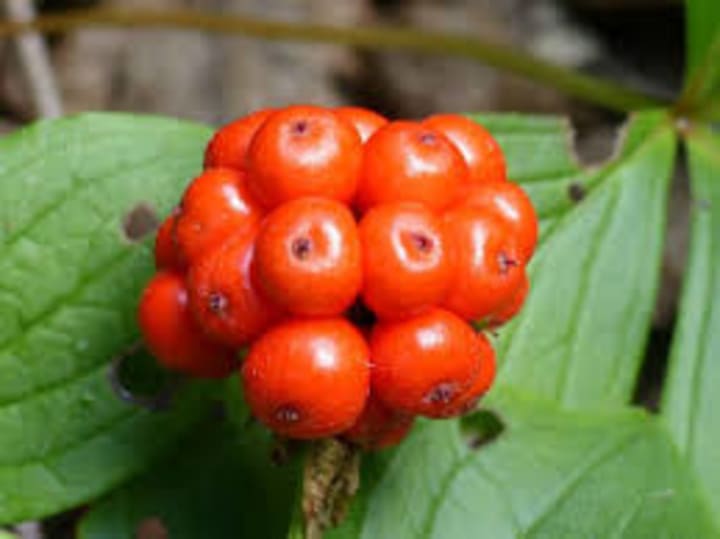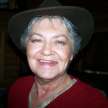A Sweet Smoke - Scarlet Stoneberry
One thing all the different Native American tribes had in common, they all happily gathered and dried bunchberry leaves and smoked them. Bunchberry was a substitute for smoking tobacco that provides a mellow “high” or euphoria and acts as a reliable pain reliever.

Bunchberry plants are appearing through the snow, and the flowers will soon follow. Spring is here and wild harvesting can begin in earnest.
By: Marlene Affeld
Bunchberry (Cornus canadenis) also regionally known as dwarf cornel, scarlet stoneberry, dwarf dogwood, cracker berry, pudding berry, pigeon berry or squirrel berry is a low growing, creeping forest plant native to North America. In northeastern Canada, native people use bunchberry as a food staple and call the brilliant red fruit "matagon." The Chipewyan tribe named the useful medicinal plant "jikonaze" and the Cree people called the plant "pihew mina" or grouse berry. The Cree also reference the plant as "kawiskowimin" or itchy chin berry. When the ripe berries are crushed and rubbed against the skin, the juice of the berry provokes a skin irritation or itchy skin sensation.

People of Ojibwa tribe enjoy a tea made from the finely ground plant root to calm digestive problems in children and adults and to relieve colic in infants. Historical "wood's wisdom" advises making a tea made from the roots of the bunchberry plant to treat "fits" or seizures. Combined in a tea with wintergreen and mint, the herbaceous plant was used to medicate menstrual cramps and to prevent bed-wetting in young children. In the Pacific Northwest, Native American tribes found a diverse array of uses for the plant and berries, including a tea made from blueberries and bunchberry to relieve the symptoms of kidney stones.

The Hoh and Quileute tribes reverently used the berries in scared religious ceremonies, brewing an invigorating and vision inspiring tonic from the tender bunchberry bark. The Makah tribe used the berries as a staple energy food and called them "bubkawak-tibupt" or “sweet fruit with stones.” When ripe, the berries present a pulpy pale yellow flesh with a hard seed. Many Native American tribal medicine men and healers relied upon bunchberry tonic to treat allergies, infections, colds, and flu.
A Sweet Smoke

One thing all the different tribes had in common, they all happily gathered and dried bunchberry leaves and smoked them. Bunchberry was a substitute for smoking tobacco that provides a mellow “high” or euphoria and acts as a reliable pain reliever. The smoke from the bunchberry plant leaves was believed to have healing properties and provided relief for those individuals suffering from nasal congestion and upper mucus membrane or lung infections.

Other devotees of the amazing bunchberry plant burned the leaves and applied the powered ash to topical skin infections, ulcerated sores, scrapes, burns, and insect bites. Fresh bunchberry leaves were applied to cuts and open wounds to stop bleeding. Because the bunchberry plant has such strong antiseptic, antibiotic, and anti-inflammatory properties, tinctures made from the leaves and berries were used to treat coughs, fevers, stomach infections, and kidney problems. Too many berries can give you a tummy ache; bunchberries berries produce a laxative effect and can cause stomach cramps. A few ripe berries, steeped in water, are an excellent appetite stimulant.

Despite its host of different odd sounding and off-putting names, the humble bunchberry is an attractive low-growing ground cover useful in urban and rural landscaping. The low-growing plant resembles a dwarf dogwood. In fact, bunchberry is a member of the dogwood (Cornaceae) family of plants. The vigorous perennial grows from thin creeping rhizomes that, if allowed to spread naturally, quickly carpet the forest floor with a lush deep green mat. Bunchberry displaces erect flowering stems with tiny "button-like" lemon yellow flowers, completely surrounded by delicate white bracts. The bunchberry plant grows to a mature height of 4- to- 6 inches.

In late summer, the edible fruit turns a brilliant red. The tart, flavorful red berries provide food for wildlife. The berries are a favorite food of songbirds, pheasants, grouse, quail, wild turkeys, squirrels, gophers, marmots, chipmunks, elk, and deer. The charming little bunchberry plant thrives from Alaska to California, being especially abundant throughout western Canada. In the northeastern portion of North America, the hardy herbaceous ground cover can be found from Ontario to Maine. The berry is also found along the northeastern coast of the United States.
The Canada bunchberry (Cornus unalaschkensis Ledeb), is slightly larger with a purplish tinge to the tips of the leaves, thrives in high acidic woodland soil, rapidly filling in barren spots of soil where other plants cannot grow. Bunchberry is hardy in United States Department of Agriculture climate zones 2- through 7.
Bunchberry grows best in cool, damp and shady locations, typically thriving on the moist floor of coniferous forests. In mild coastal climates, the leaves are vivid green and evergreen all year long. The tough little plant can be seen growing from rotting logs and decomposing stumps. The delicate flowers appear in late May or June, often later at locations of high elevation. When the white bracts fall during the warm days of early summer, the berries start to form.
Bunchberry frequently flowers a second time in early autumn. When established in home landscapes and country gardens, bunchberry is a visually inviting and easy to grow ground cover around the base of shrubs and trees. Bunchberry thrives in compacted heavy clay soils. Bunchberry spreads quickly and requires little care. Provide a thick layer of organic mulch and plenty of water. Bunchberry establishes readily in partial sunlight or shaded areas.
Bunchberry berries are rather bland. The fruit can be eaten raw or stewed as a tasty pudding. Bunchberries are typically blended with other wild berries and used in syrups, pies, cobblers, jellies, juices, sauces, and jams. Bunchberries are high in pectin and are often used to thicken stewed dishes of other types of berries or fruit.
About the Creator
Marlene Affeld
“A passionate writer for more than 30 years, Marlene Affeld’s passion for the environment inspires her to write informative articles to assist others in living a green lifestyle.”






Comments
There are no comments for this story
Be the first to respond and start the conversation.